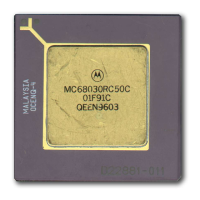Signal Description
5-8
MC68030 USER’S MANUAL
MOTOROLA
5.8 INTERRUPT CONTROL SIGNALS
The following signals are the interrupt control signals for the MC68030.
5.8.1 Interrupt Priority Level Signals
These input signals provide an indication of an interrupt condition and the encoding of the
interrupt level from a peripheral or external prioritizing circuitry. IPL2
is the most significant
bit of the level number. For example, since the IPL
n signals are active low, IPL0–IPL2 equal
to $5 corresponds to an interrupt request at interrupt level 2. Refer to
8.1.9 Interrupt
Exceptions
for information on MC68030 interrupts.
5.8.2 Interrupt Pending (IPEND
)
This output signal indicates that an interrupt request has been recognized internally and
exceeds the current interrupt priority mask in the status register (SR). This output is for use
by external devices (coprocessors and other bus masters, for example) to predict processor
operation on the following instruction boundaries. Refer to
8.1.9 Interrupt Exceptions
for
interrupt information. Also, refer to
7.4.1 Interrupt Acknowledge Bus Cycles
for bus
information related to interrupts.
5.8.3 Autovector (AVEC
)
This input signal indicates that the MC68030 should generate an automatic vector during an
interrupt acknowledge cycle. Refer to
7.4.1.2 Autovector Interrupt Acknowledge Cycle
for more information about automatic vectors.
5.9 BUS ARBITRATION CONTROL SIGNALS
The following signals are the three bus arbitration control signals used to determine which
device in a system is the bus master.
5.9.1 Bus Request (BR
)
This input signal indicates that an external device needs to become the bus master. This is
typically a "wire-ORed” input (but does not need to be constructed from open-collector
devices). Refer to
7.7 Bus Arbitration
for more information.

